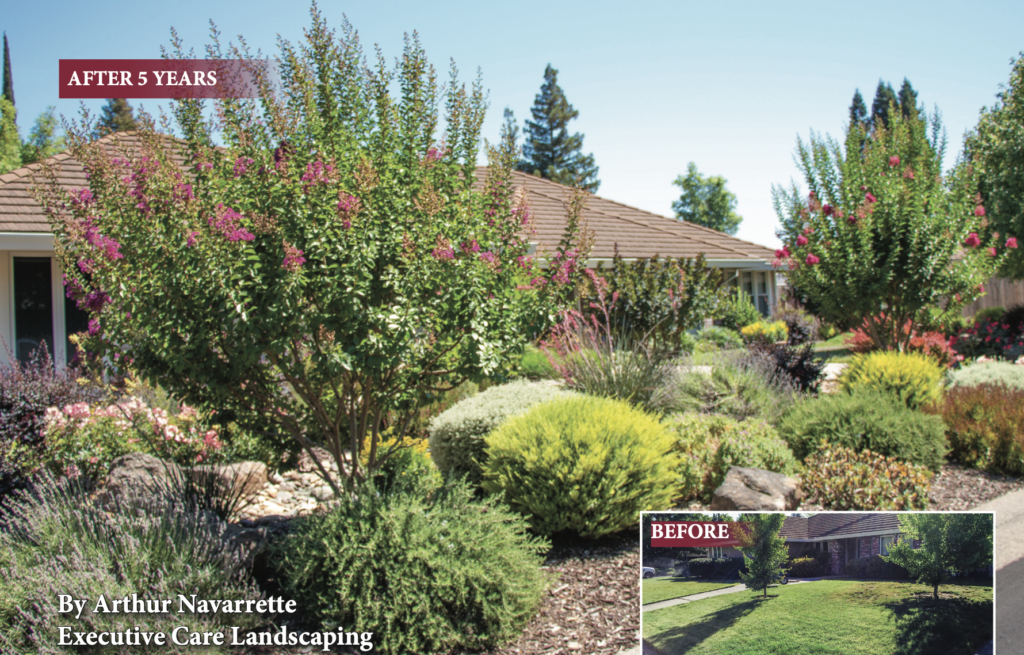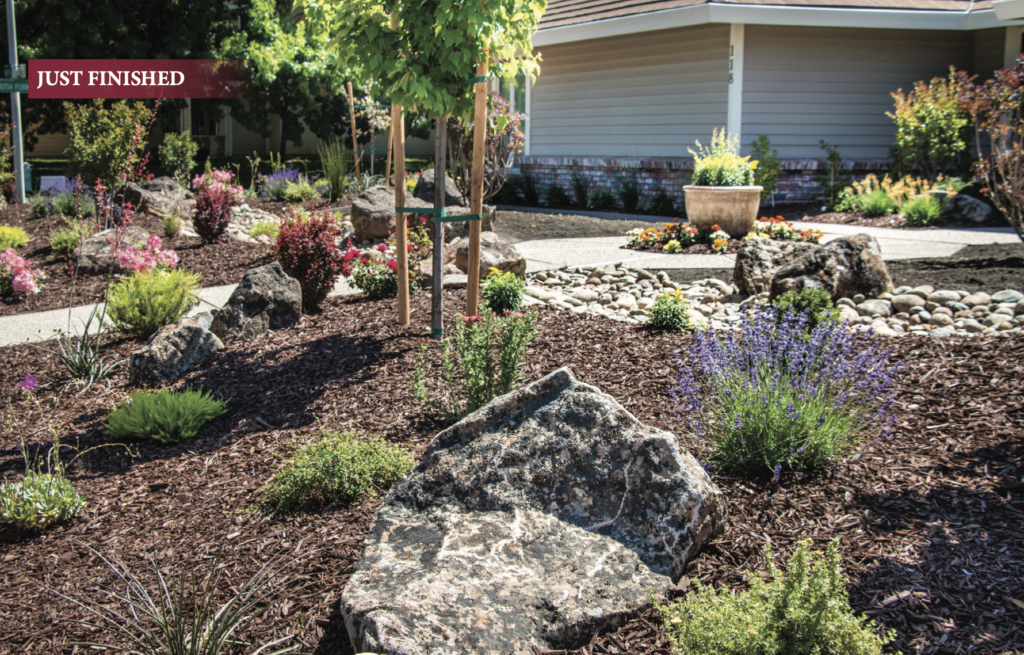Welcome to July’s article. It has been a crazy several months with all that has been happening. At the time ofthis writing (6/25/2020), we are beginning to see the light at the end of the tunnel. Businesses are opening, and restaurants can now seat patrons. Some businesses saw an increase in their business during this time, mostly those dealing with home improvement and/or repair. Landscaping has done well due to people being home and wanting to improve their surroundings, but it’s hard to be happy when it comes at the expense of others. I hope your employment has stayed steady, and you and your family are well. While travelling throughPlacer, Sacramento, and El Dorado County, I have found that the COVID concern has been minimal. For those of you that have been working from home and have not ventured out more than to the grocery store, I hope this comment brings some much-needed good news.

For this month, I want to view a yard/landscape we featured 5 years ago in 2015. It was a fun job. Lynda was a great client and is still a good friend. We did her job during the drought. Her front yard prior was all sod. By removing her lawn and installing plants with drip irrigation, we cut her watering needs down to 1/3rd of what she was using. Though her front yard is sizable with many plants, the water savings is still way under what lawn would be. Lawn nozzles put out approximately 2.62 gallons of water a minute, and she had 60 sprinklers, which would be 157 gallons of water a minute times 10 minutes. This equals 1570 gallons per each watering. Three days of water equals 4710 gallons of water a week! Even if you have 400 drip emitters (which is 200 plants), it only equals 400 gallons of water (gph). When you do the math, drip irrigation is the best way to go for water conservation. Also, since “green” is a color we are accustomed to having in our yards, we incorporated Kurapia as a lawn alternative. Kurapia does attract bees, so it might not be your solution for green, however it is also wise to not over install lawn. Gone are the days of large lawns and small planters. I hope through my writings I have given you enough reason to reverse that mindset. Install the amount of lawn you need to entertain with or raise kids on, but let’s be creative with the rest of the yard.
Lynda’s front yard is the largest residential front yard we have landscaped (last month’s featured landscape is the largest custom front yard landscape we have completed). Because Lynda’s front yard was sizable, one of the obvious goals was low maintenance. The last time it was pruned was this past January, and now six months later it is still looking pretty good with only the Chinese Fringe Flower (purple ones) being recently pruned. So, it is possible to select plants that require minimal care, but you must know your plants. It is way too complicated to explain what plants I put next to others and why, but I can explain the general placement of plants from the house out to the street. As you have seen in other featured articles, we have completed much steeper yards than this one, and the steeper the yard, the more of what I am about to say is true. We all know that water travels downhill, so my general placement and selection of plants is determined by this factor. The plants at the top are one group; they are the more drought tolerate ones. The ones in the middle have average water needs, and the ones by the street do not mind having damper soil. Most landscapers do not even consider this, or even know to consider this. The slope/grade here is very gentle except for the last five feet. The divide for this yard really occurs at the stream bed.

The same principles of plant placement apply to drip irrigation. We will add drip irrigation according to the shade/sun exposure as well as the slope. For example, if the sun exposure is the same throughout the yard, we will have a valve control the lowest 8’ ft. portion – one valve to water the middle and one valve to water the upper section. At times, the yard is not sloped enough or wide enough to have three divisions, so we divide it into two irrigation water zones. Each water zone can use several valves or just one, depending upon the size of the yard. If the yard has a shadier portion, we divide that section and give it a separate valve. For Lynda, the landscape to the left of the driveway receives more shade than the rest of the landscape, so that section was parted out and given its own valve. This type of division, as opposed to just adding one valve per every 30 plants regardless of sun, shade or slope makes the job easier and faster, but it affects the overall health and longevity of the landscape. Because of how we install the irrigation and divide out the plants, our prices tend to be more, however proper watering and plant placement is everything to the health of the landscape and is directly connected to your enjoyment of the yard. No one likes to look at sick plants, and considering the number of plants we have here, I only saw one that was yellow.
Everything with this yard is on the large size. Some of the boulders are 800 to 900 pounds and the dry stream is close to 4’ wide. The boulders had to be placed with a forklift. Underneath the stream bed we added a perforated drain line or leach line. Before the drain line enters the stream bed, the drain lines are solid (non- leach) and they are connected to the downspouts of the house. During the installation of this yard, we were in the drought. We did many such stream beds with perforated drains underneath them. It is important to remember that our largest “water footprint” for capturing water is our roofs. We capture and discharge more water from our roofs than any other aspect of a residential home. Our goal in doing this therefore, was to keep the water on the property, deep watering the trees and shrubs and hopefully recharging our ground water. During this time, we had much support from our clients, but now not so much. It cost a bit more, but I believe it is worth doing. We can go into a dry cycle at any time, but I must respect my clients wishes if they choose not to. Finally, because of the size of this yard I have included a video – enjoy.
Gardeners – we are well into the summer growing season. Pay attention to your watering. No one likes watery tasting tomatoes. Let the soil dry out a bit, and then water. On hot days, the sun can scorch the tomatoes, as well as bell peppers, some chiles and other vegetables, so be prepared to cover them. Until next time, good gardening.
Arthur
